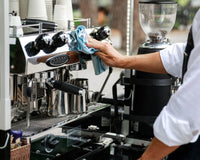WHAT DOES A BARISTA’S JOB LOOK LIKE?
Barista’s have many responsibilities throughout their workday. Below we’ve compiled everything you need to know as a barista, from making coffee to cleaning at the end of the day. Not every cafe is exactly the same but here are the basics to get you started.
BEGINNING OF DAY/OPENING SHIFT ESPRESSO MACHINE SET-UP
At the beginning of your day when setting up your machine, it is necessary to run shots through each portafilter. These shots are called "seasoning shots"¥. This is done to ensure that any debris, cleaning detergent, etc. that may have settled overnight in your machine is flushed out prior to making your first customer's drink. At this time you will also be able to see where your grind is and make adjustments accordingly.
ESPRESSO EXTRACTION
Know your recipe and variables: Just like with baking or making cocktails, making awesome espresso requires knowing how much of each ingredient you need and the variables you can control to ensure your desired shot. Luckily espresso only has two ingredients: finely ground coffee and water. When it comes to espresso, the more precisely you measure your ingredients the more consistent your shots will be. Whether you are using volumetrics or a scale that can measure within .10 of a gram it is important to understand your goals and which variables will affect your results.
Your Variables:
Grind: Your grinder is where good espresso preparation begins. A high quality grinder with big sharp burrs will produce more even and consistent little coffee particles to extract all the good coffee flavors from. A barista can adjust the size of particles the grinder producers by tightening or loosening the grind. Tightening makes the grind finer and loosening makes the grind courser.
Dose: Your dose is the amount of coffee you place in your portafilter. It is the coffee part of your recipe. Your range of dose is dictated by the size of basket you are using. Whether it is a 7gr single basket, a 14-18gr double, or a 18-22gr the dose you use should fit within the range the basket was built for. You can train yourself to be pretty consistent eyeballing your dose or you can use a scale and measure within a tenth of a gram. Either way, if you have an inconsistent dose, your shots will vary drastically.
Distribution: Once the coffee is in the portafilter basket, often it is necessary to move the ground around a bit to create an even bed of coffee. There are many ways you can choose to distribute coffee within the portafilter basket. Some baristas use their finger or a fancy distribution tool and others just tap the edges of the portafilter to move the grounds around in the basket. The goal here is to be as even as possible before tamping.
Tamping: This is the process of compacting the coffee grounds into the portafilter. Tamping serves two purposes; one is to create headspace between the grouphead and the coffee, the other is to evenly pack the coffee ground to their maximum density.
Learn more about proper tamping here.
Extracting: Description of measure volume or brew weight as well as time. Leave the specific quality standards open for different interpretation (crema, volume, time etc.)

HOW TO STEAM MILK FOR ESPRESSO DRINK BUILDING
There are two phases to steaming milk.
Phase 1 "Stretching" - Air is introduced to texture the milk.
Phase 2 "Steaming" - Milk is then heated up to bring out its caramelized sugars.
Properly textured and steamed milk will enhance the flavor, bringing out the sweetness in the espresso, and will deliver an almost desert like quality.
Heating with steam alters the milk's chemical composition and creates a different flavor that blends with the espresso perfectly.
MILK STEAMING TIPS
Always start with cold milk, keeping in mind that milk with a lower fat content is usually easier to texture.
Use the correct size pitcher for the amount of milk you are steaming.
Learn to pour only the amount of milk needed for the drink you are making in the most appropriately sized steaming pitcher. Keep in mind when pouring your milk that the amount you pour can expand to as much as double the original volume with steaming. Purge the steam wand.
Start introducing air up to 100 degrees. This is achieved by holding the steam tip just under the surface of the milk,"stretching"¥ the milk while it is expanding.
Begin to "roll" the milk by plunging the steam wand entirely into the pitcher creating a rapid, swirling circulation. Bring the temperature up to 140 degrees or when pitcher is too hot to touch.
Bang out any bubbles by hitting the pitcher on the counter, swirl the steamed milk to prevent separation from beginning to occur.
When these steps are followed, "Latte Art" will become second nature.
Things to avoid while steaming:
- Bobbing the pitcher up and down
- Moving pitcher in circular motion
- Setting pitcher down while steaming
Your goal is to create fine, velvety, small-celled, textured, foamed milk.
HOW TO CLEAN AN ESPRESSO MACHINE
- Soak portafilters and baskets separately, in hot water with EP Clean or other commercial espresso machine detergent for several minutes. Make sure the handles are not exposed to the cleaner as the detergent will damage handles.
- Rinse with hot water. Backflush using blind filter and EP Clean. Turn water on for 10 seconds, stop then turn on for an additional 10 seconds. Continue this procedure until water becomes clear. Back flush again using same procedure, without using any detergent. Scrub inside of group head. Wash drain trays, portafilters, baskets, etc. Never use a scouring pad on any part of your machine, it can remove the metal plating and damage it.
Your espresso machine may have a built in cleaning program, if so, please follow those instructions.
A trained service technician should service your machine every 6 months.
HOW TO CLEAN AN ESPRESSO GRINDER
Clean with Grindz weekly. Periodically, open up your grinder and fully clean with a shop vac cleaning tool to ensure that the burrs are free of all coffee oils.
It is important to wash the hopper with hot soapy water to prevent espresso bean oils from building up and becoming rancid. Brush out all excess grounds from inside of doser and wipe inside and outside with a dry paper towel nightly.






